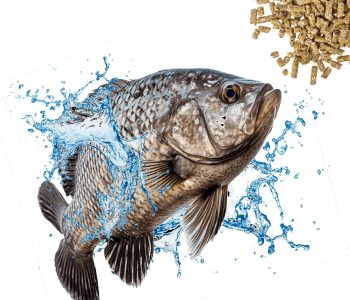Foundations of Fish Nutrition
Aquaculture plays a significant role in supplying animal protein of excellent biological value to consumers in the brazilian national production context, with particular emphasis on tilapia farming.
This species is the flagship of the activity, and among all the favorable characteristics for its cultivation, its fillet stands out as a noble element with light coloration, mild flavor, and absence of “Y” bones, facilitating its consumption. This versatility allows for the preparation of various recipes for consumption.
However, despite these notable attributes, there are various stages and processes involved before this fish makes its way to the consumer’s plate, with fish nutrition and feeding on the farms standing out as fundamental components in this chain.
It’s important to note that in their natural environment, these aquatic organisms are capable of sourcing their food at desired times and locations, a capability that becomes impossible in captivity.
Well, then, how can we ensure that confined fish receive all the necessary nutrients correctly for their productive or reproductive performance and maintenance??
Firstly, it is essential to recognize these nutrients and how they can be efficiently allocated to the particular species. It is well-established that the most critical macronutrients for fish are: [register]
From this point, details such as the developmental stage of the fish and production objectives become decisive, as these factors will guide the formulation of a diet. Therefore, understanding the nutritional requirements is a key point in balancing feeds, as any imbalance in the formulas can impact the fish’s performance.
| However, the typical approach to referring to feeds has traditionally been based on their crude protein content, which remains the method by which most producers distinguish their stocks. However, with technological advancements and further research, there is now a more precise method of formulating diets, focusing not on protein levels in a general sense, but rather on the quantities of amino acids, the building blocks of protein. |
Thus, feeds have become much more precise, and most importantly, the impact they have on both the productive performance of the animals and the maintenance of the production environment is crucial.
Furthermore, and equally significant, lipids are essential components because they serve various functions in organisms, including:
Furthermore, various fish species have distinct requirements for essential fatty acids, primarily because of the absence of desaturase and elongase enzymes, which can produce long-chain carbon molecules with double bonds in their carbons.
Understanding the physiological functioning of lipids is crucial for providing elements that enable animals to efficiently produce fundamental molecules for their development and, thereby, utilize available resources to promote both lipogenesis and lipolysis effectively.
The last macronutrient included in fish diets is carbohydrates. This nutrient serves as an interesting energy source for living organisms and is also available as a reserve (glycogen) during periods of decreased serum glucose or during physical exertion.
Conversely, carbohydrates play a crucial role in feed processing. This is exemplified by the gelatinization of starch during extrusion, leading to decreased pellet density—thus enabling buoyancy—and enhancing the digestibility of this component. However, comprehending the metabolic pathways of carbohydrates in aquatic organisms is crucial yet remains obscure.
| Fish species with different feeding habits have diverse methods of managing simple sugars in their bodies, and it’s essential to study these pathways thoroughly to conclusively understand the true significance of this nutrient for fish. |
Well, it’s practically impossible that the supply of macronutrients alone is sufficient for any developing organism.
This fact is underscored by the necessity to break down these molecules—whether they are polymers or not—into smaller units that can be assimilated and subsequently utilized for anabolism.
To accomplish this, it would be unattainable without the presence of vitamins and minerals, which, alongside other functions, act as coenzymes and enzymatic cofactors in animal metabolism.
Clearly, their contributions to maintaining the homeostasis of individuals do not conclude with these functions.
| Nutrition is but a single element of the production chain and should not be viewed in isolation. Keep this in mind! |
References available upon request.[/register]
